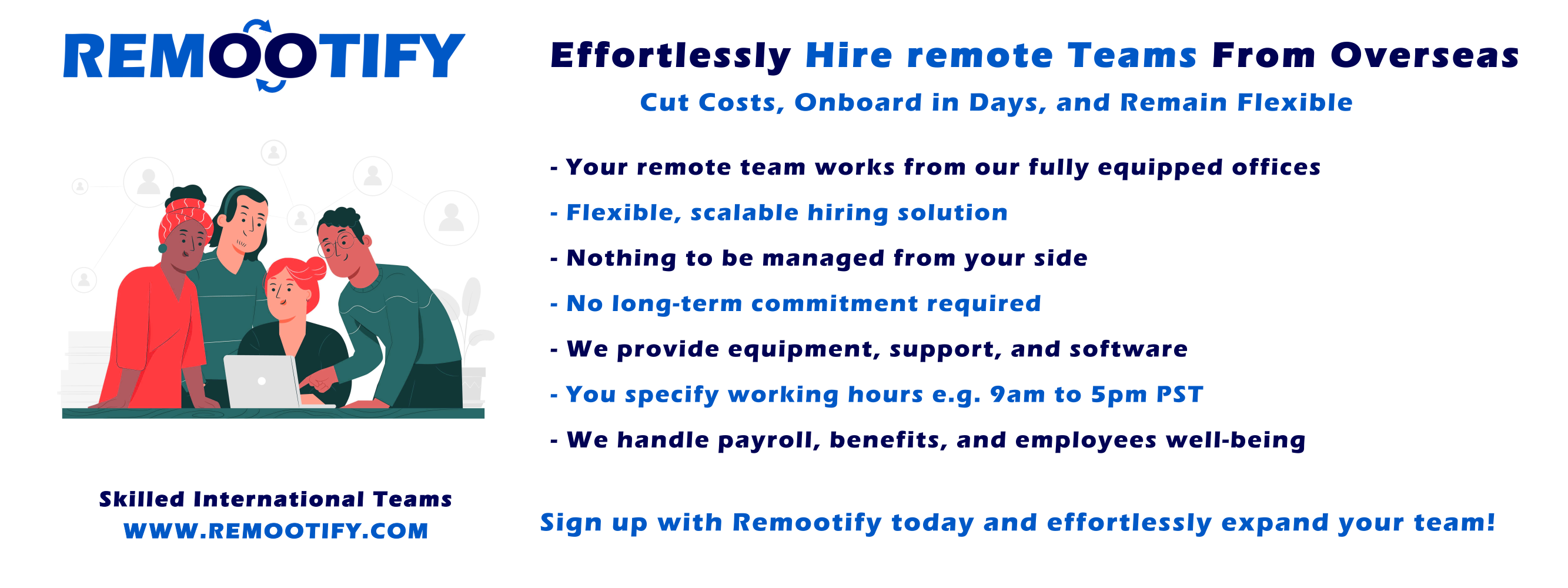Start hiring YOUR REMOTE TEAM, Today!
Enter your information below to start a discussion with one of our team members!

Wondering what a fixed-term employment contract is and when it’s used? It is essentially a contractual agreement between an employer and employee for a specific time period. In this article, we’ll explore the ins and outs of these contracts, from benefits to potential risks, helping you make informed decisions about their use.
Eager to uncover more? Let’s dive in!
Key Takeaways
- A fixed – term employment contract is an agreement between an employer and employee for a specific period of time, with a clear start and end date.
- Benefits for employers include the ability to easily manage contract length, flexibility in staffing to meet demand, and fewer liabilities compared to permanent employment.
- Risks for employers include recruiting challenges, incohesive workforce, and differing employment laws.
- To effectively manage a fixed – term employment contract, employers must understand how to terminate the contract, determine when it should be used, and include specific details in the agreement.
What is a Fixed-Term Employment Contract?
A fixed-term employment contract is a contractual relationship between an employer and employee for a specified period of time, with a clear start and end date. It is also referred to as a temporary or short-term contract.
Definition
A fixed-term employment contract is a deal made between a boss and a worker. It comes with an end date that both sides know about from the start. The time can be short like weeks, or long like years.
This type of contract often states when work will start and stop. It also lays out what kind of work needs to be done. When the time ends, so does the job unless the boss decides to renew it.
How it works
A fixed-term employment contract is a type of agreement where both the employer and the employee agree on a specific end date for their working relationship. It is commonly used when there is a temporary need for workers, such as for a specific project or to cover staff shortages.
The duration of the contract can vary, ranging from just a few weeks to several years, depending on what the employer needs. Once the contract reaches its end date, unless it’s renewed or extended, the employment automatically ends.
This means that both parties are aware in advance about how long they will be working together. Employers must make sure they follow labor laws and treat employees fairly during this period.
Pros of a Fixed-Term Employment Contract
Fixed-term employment contracts offer benefits for employers, including the ability to easily manage a defined contract length, flexibility in staffing to meet fluctuating demand, and fewer liabilities compared to permanent employment.
Benefits for employers
Fixed-term employment contracts offer several benefits for employers. Firstly, they provide a defined contract length, allowing employers to easily plan and manage their workforce.
This is especially beneficial for businesses that require temporary workers for specific projects or seasonal demands. Additionally, fixed-term contracts enable employers to have flexible staffing options without the long-term commitment of permanent employment.
Employers also benefit from having fewer liabilities with fixed-term contracts, as they do not need to provide the same level of job security and benefits as permanent employees. Furthermore, these contracts allow employers to quickly adjust their workforce based on changing business needs without having to go through lengthy termination processes or legal procedures.
Defined contract length
A fixed-term employment contract is an agreement between an employer and an employee that has a specified duration. The contract clearly states the start and end dates of employment, which can range from a few weeks to several years.
This allows both parties to understand how long the employment relationship will last and helps avoid any confusion or disputes later on. It’s important for employers and employees to review and agree upon the defined contract length before entering into the agreement to ensure everyone is on the same page.
Flexible staffing
Flexible staffing is one of the benefits of using a fixed-term employment contract. With this type of contract, employers have the flexibility to hire employees for specific projects or during temporary staff shortages.
This means that they can adjust their workforce according to their needs without having to commit to long-term employment contracts. It allows companies to efficiently manage their staffing levels and ensure that they have the right people in place when they need them.
For employees, flexible staffing can provide opportunities for short-term work or fill-in positions, allowing them to gain experience and potentially explore different roles within an organization.
Fewer liabilities
Using fixed-term employment contracts can result in fewer liabilities for employers. Since these contracts have a predetermined end date, employers are not obligated to provide long-term benefits or severance packages when the contract expires.
This reduces financial risks for the company and allows them to adapt their workforce based on fluctuating business needs. Additionally, if an employee’s performance is unsatisfactory during the fixed term, it is easier for the employer to end the contract without facing legal challenges related to unjust dismissal or breach of permanent employment rights.
Cons of a Fixed-Term Employment Contract
Risks for employers include recruiting challenges, incohesive workforce, and differing employment laws. Read more to learn how to manage a fixed-term employment contract effectively.
Risks for employers
Employers face certain risks when using fixed-term employment contracts. One risk is the difficulty of recruiting qualified candidates who are willing to work on a short-term basis.
It can also be challenging to maintain a cohesive workforce, as employees may come and go frequently. Additionally, employers need to navigate differing employment laws and ensure they comply with basic labor rights, such as avoiding unjust dismissal.
These risks highlight the importance for employers to carefully consider whether a fixed-term contract is appropriate for their staffing needs and to manage these contracts effectively.
Recruiting challenges
Recruiting for fixed-term contracts can pose some challenges for employers. One challenge is finding qualified candidates who are willing to accept temporary employment. Some job seekers may prefer the security and stability of a permanent position.
Additionally, short-term contracts may not offer the same level of benefits or job security as permanent roles, making it harder to attract top talent. Furthermore, there may be a limited pool of candidates available with the specific skills or experience needed for the temporary role.
Employers must also consider that recruiting for fixed-term contracts requires careful planning and coordination to ensure that they find suitable candidates within a limited timeframe.
Incohesive workforce
An incohesive workforce is a common challenge that can arise with fixed-term employment contracts. Since these contracts have specified end dates, employees may feel less committed or connected to the company and their colleagues.
This lack of cohesion can affect teamwork, collaboration, and overall productivity. It’s important for employers to foster a sense of inclusion and engagement among all workers, regardless of their contract status, to help mitigate this issue.
By promoting open communication, providing opportunities for team-building activities, and recognizing the contributions of all employees, companies can work towards creating a cohesive and harmonious work environment.
Differing employment laws
Different countries have varying employment laws when it comes to fixed-term contracts. These laws govern aspects such as contract duration, termination rights, and employee benefits.
For example, in some countries, there may be restrictions on the maximum length of a fixed-term contract or requirements to provide certain benefits to employees with such contracts.
It is important for both employers and employees to understand the specific laws and regulations in their jurisdiction to ensure compliance and protect their rights.
How to Manage a Fixed-Term Employment Contract
Managing a fixed-term employment contract involves understanding how to terminate the contract, determining when it should be used, and including specific details in the agreement.
How to terminate
Terminating a fixed-term employment contract can be straightforward if both parties understand and follow the agreed-upon terms. When the specified end date of the contract arrives, the employment relationship automatically comes to an end unless there is a renewal or extension.
It is crucial for employers to communicate with employees well in advance about the termination and any potential options for renewal or extension if applicable. Employers should also ensure that all final payments and entitlements are settled correctly according to labor laws and regulations.
By following these procedures, both employers and employees can smoothly conclude their contractual obligations without any misunderstandings or disputes.
When to use
Employers may choose to use a fixed-term employment contract when they have specific temporary staffing needs or short-term projects. These contracts are commonly used when businesses require additional help for a limited time or need to cover staff absences.
By using fixed-term contracts, employers can ensure that they have the necessary workforce without committing to long-term employment. Additionally, these contracts provide flexibility in managing and adjusting their staffing levels according to business demands.
It is important for employers to comply with relevant labor laws and regulations concerning the use of fixed-term contracts to protect employees’ rights and avoid any potential legal issues.
What to include in the agreement
When creating a fixed-term employment agreement, there are important details that should be included. This includes the start and end dates of the contract, specific job responsibilities or tasks, hours of work, compensation and benefits, any probationary period, termination conditions or notice requirements, and any confidentiality or non-compete clauses.
Additionally, it’s essential to include provisions for annual leave entitlements and how disputes will be resolved. By including these key elements in the agreement, both employers and employees can have a clear understanding of their rights and obligations during the term of the contract.
Conclusion
In conclusion, a fixed-term employment contract is an agreement between an employer and employee for a specific period of time. It can provide flexibility for employers and opportunities for employees.
However, there are legal considerations that both parties must be aware of to ensure fair treatment and compliance with labor laws. Understanding the terms and conditions is crucial to avoid disputes or misunderstandings during the contract period.
FAQs
1. What is a fixed-term employment contract?
A fixed-term employment contract is a form of temporary or non-permanent contract that lasts for a certain amount of time.
2. How does the term of contract affect my job in short term and long term?
The duration of your employment under a fixed-duration or time-limited contract depends on the rules outlined in the agreement. It can range from seasonal jobs to project-based work.
3. Can I get an example of when I might have a limited-term or fixed-term employment?
You may be given a short-term, temporary, or limited-term gig if you’re hired for seasonal tasks, special projects, or cover someone on leave.
4. What happens when my contractual period ends?
At your contract expiration, your employer might renew it or end your job based on their business needs and also following certain termination procedures as stated in the agreement.
5. Where can I find examples/templates for creating such contracts?
Fixed term contracts templates/examples are available online where details like terms, roles and duration can be filled according to specific needs.





